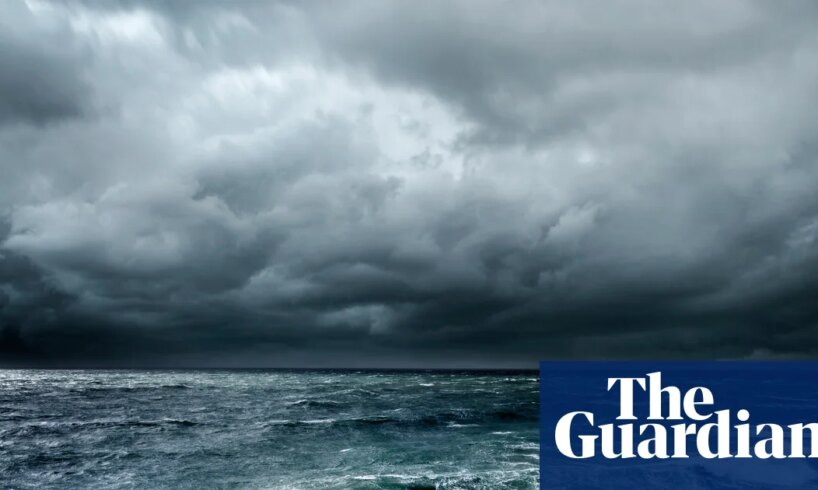
The Scandies Rose fishing boat set out to sea from Kodiak, Alaska on 30 December 2019 with a crew of seven, into weather as bad as anything December could throw. “It was enough of a shitty forecast,” said one of the crew in later testimony, “I didn’t think we were going to leave that night.” At 8.35pm, fierce, frigid winds were blowing. Some boats stayed in harbour but the Scandies Rose still set out. “We knew the weather was going to be bad,” said deckhand Dean Gribble, “but the boat’s a battleship, we go through the weather.”
The boat was carrying 7,000kg of bait and was headed north towards the Bering Sea. “She was trim, said Dean, and a good boat. Gary Cobban was a good captain. One of the last jobs before departure was to stack the crab pots properly. There were 198 on board. That is a heavy load but not unusual. Each pot measured more than 2 metres by 2 metres. “Big, heavy fucking pots,” Gribble said.
The stack was huge. Gribble had to climb all over it. It was four or five pots high and with all his checking and re-checking, his legs and arms were burning. “The pots were stacked great,” said Gribble. Every row had a chain on it, “and it was tied down a lot. There were ties everywhere. They were tight.” Crab pots stacked badly could affect stability, and lack of stability can sink a boat. When the US Coast Guard had begun doing pre-departure stability checks in Alaska ports in the 1990s, fatalities and sinkings were reduced by almost 70%. Cobban expected conditions to be “icing”, and a crab pot laden with ice can weigh more than 1,000kg. “Fuck,” said Gribble. “It seemed fine.”
The crew was Gary Cobban, David, Gary’s son; the engineer, Arthur Ganacia; Brock Rainey, who had fished with Gary for 15 years or so, and Seth Rousseau-Gano. Jon Lawler was on board, and his friend Dean Gribble, who was new but only to this boat – he had been fishing since he was 11. The captain did a safety drill. This covered where the emergency position-indicating radio beacon (EPIRB) was located, how to make a mayday call, and where the fire extinguishers were. A crew member demonstrated how to put on an immersion suit. These survival suits are waterproof full-body garments with a hood and integral three-finger gloves and boots. They are bulky and hard to get on but far more likely to save your life in cold water than a lifejacket.
The Scandies Rose departed. First north-east then north-west towards the Bering Sea. The forecast looked like this: wind 15 knots, becoming SW 25 knots in the afternoon; seas 3 feet, building to 6 feet in the afternoon; freezing spray. There are many people who listen to the BBC’s Shipping Forecast because they find it soothing. That is because they are not where the weather is. There was nothing soothing about that forecast.
The first day was testing but OK. On 31 December, Gribble’s hour-long watch finished at 7.15 pm. He woke Cobban to take over and told him the boat was leaning to one side. “It wasn’t too crazy. Maybe one degree.” The wind on the forward and starboard beams was approaching 60–70 knots. On the Beaufort wind force scale, a measure of wind at sea and on land, this wind speed counts as Violent Storm and only Hurricane is stronger.
Soon the freezing spray was hitting the starboard side of the boat. “We were building ice,” says Gribble, “but again it wasn’t anything crazy.” Cobban was aware of it, and when he came to take the watch Gribble asked whether they should go outside to try to chip the ice off. This would be standard practice if the weather allowed. Cobban, a cautious captain, said they would wait to get to shelter, and Gribble was relieved. “It was shitty out and I didn’t have any qualms.” He went below, had something to eat, and then headed to his “rack”, as fishers call their bunks, and began to watch a film.
In the United States, if you want to die on the job, you should become a logger or a commercial fisher. These two jobs occupy the top two spots on the highest risk careers. The National Institute for Occupational Safety and Health calculates that fishing is 40 times more dangerous than any other job. England’s Marine Accident Investigation Branch (MAIB) puts the rate of fatalities in the fishing industry at 100% higher than in the UK general workforce, with 85% of those involving people ending up in the water.
For a country that is thought to have the best-regulated fisheries in the world, the US is an odd fish when it comes to mandatory safety requirements. It was only in 1988 that it became mandatory for US boats to carry safety equipment such as life rafts and an EPIRB, a locator beacon that should detach on sinking then float. UK fishers must complete four safety courses as a condition of their licence. US fishers do not need a licence unless their vessel is more than 200 US tons. “That’s a tiny percentage of the fishing fleet,” says Jerry Dzugan, a former fisher who provides safety courses in Alaska. “Vessels this size are built to or reconfigured to be 199 tons to avoid having licensed crew.”
In the US, the only mandatory safety training is an eight-hour course instructing how to use survival gear and conduct an emergency drill, but that is only for boats that carry more than 16 crew or operate in certain latitudes. After that, they have monthly drills that can be carried out on board or ashore; they don’t have to be done by a crew member and enforcement and oversight varies widely.
Above 32 degrees latitude in the Atlantic Ocean, commercial fishing vessels must carry immersion suits. Below that latitude, they must carry lifejackets, also known as personal flotation devices (PFDs). In other waters, the dividing line is 35 degrees. The PFDs have to be on the boat. Fishers do not have to wear them.
Crewmen on the deck of a trawler in the Bering Sea, Alaska. Photograph: Natalie Fobes/Getty Images
Between 2000 and 2020, there were 805 deaths, 164 missing people and 2,122 people injured in commercial vessel accidents in the US. Of the 210 people who fell overboard and drowned, not one was wearing a lifejacket. That’s bewildering. Why would you not wear something that can save your life? “It’s a cultural thing,” says Dzugan. “I remember when I first was fishing in the 1980s, I would go on boats and I would ask if they had an immersion suit, and one guy threw me off his boat for even asking the question. Another example was somebody I asked where the life raft was, and he said we don’t talk about that on this boat. It’s like, if you talk about it, bad things will happen.”
I know about fishers’ superstitions. Don’t whistle on board. Never wave a fisher off to sea because a wave will bring a wave. These superstitions are not about ignorance but hope. “Fishers work and live in an environment that they don’t have control of,” says Dzugan. “They don’t have control of the fish, where they are, or how to catch them. You don’t have control of the weather. You don’t even have control of your boat in a lot of senses in that you try to maintain your boat, but unforeseen things happen: electric fires, sinking, flooding. You don’t expect it.” Superstition spins a web around the uncontrollable. Superstition is containment.
Even if you fish in waters where you carry an immersion suit, which you would never wear unless about to be immersed, why would you not wear a PFD on deck? Dzugan counts the ways. They’re bulky. You can’t work in them. They have straps and webbing, and straps are anathema on a working deck – they can snag and they can get you killed. That’s the practical stuff. There is also the machismo. “A lot of it is from, ‘I’ve been fishing for 50 years, nothing bad has ever happened to me – why should I worry?’”
Yet every fisher that Dzugan knows, and every fisher elsewhere, too, knows someone who has died at sea or had a near miss. The Royal National Lifeboat Institution publishes a leaflet called “Lifejackets: useless unless worn”. Even when fishers carry the necessary safety equipment, the compliance is grudging and superficial at best.
Back in Alaska, the weather was so atrocious that a Coast Guard rescue pilot drove to his station with his head out of the truck window so that he could see. On the Scandies Rose, Gary Cobban was on the phone. He phoned Jeri Lynn, a woman he had been seeing, to wish her a happy new year. She said later he sounded fine. They talked for 15 minutes.
He spoke about needing to “tuck in” somewhere safe. He didn’t sound stressed or worried. “He told me the boat was icing and it had a list to it, but he didn’t sound alarmed. He didn’t sound scared. The boat ices every winter. It’s just something they deal with.”
Cobban’s sister Gerry described her brother as a man who had fishing in his blood. Their dad began fishing when he was eight or nine years old. Their mum fished. Grandparents fished, parents fished, children fished. By age 20, Gary Cobban was already a captain. When Gerry and her husband went to dinner on the evening her brother left for the sea, her husband looked at the weather. “I bet your brother’s just getting his ass kicked out there.” Yes, said Gerry, because the weather was what the weather was. “But he’s a big boat and he knows what he’s doing and he’s going to be OK.”
In the Scandies Rose wheelhouse, on the last night of 2019, only two windows were heated and still functional as windows. The rest were obscured by ice. Peering and straining to see, the captain would have seen the pots were iced, but he could not have seen how much. Only going out on deck would have revealed the thickness of the ice on them. Even had that been possible, the pots had not been stacked around access alleyways, as the Coast Guard advises. The crew would have had to clamber over the stack to monitor it effectively. This was unthinkable in this violent, turbulent sea.
On a stable deck of a boat on a calm sea in a calm situation, it can take 60 seconds to put on a survival suit. That’s what Jerry Dzugan teaches people to do at his training courses. First hope you have the right size: too big and it could let in water. Then get you and your boots into it, then finally zip it up when your hands are already in the cumbersome gloves. In real life, on a terrifying sinking or rolling vessel, it would not take 60 seconds.
In his rack aboard the Scandies Rose, Gribble was still watching a film. Then the boat leaned hard. “I looked up. Jon [Lawler, his friend] got up, ran upstairs, yelled down, ‘Dean, boat’s sinking.’” Gribble got his trousers on and ran up to the wheelhouse. He threw out the survival suits to everyone from their locker. He remembers that Cobban looked “freaked out”. “We all were. It’s blowing fucking 30, 40 miles an hour. And there’s fucking ice all over the windows, so it’s fucking cold. And now I’ve got to go swimming in this shit.”
Fishers preparing crab pots. Photograph: Natalie Fobes/Getty Images
It was hard to get the suits on because the vessel was now listing by 20 degrees. Gribble got his legs in his suit by jumping into a chair in the wheelhouse and bracing himself against the armrest. He slipped, got back up, got his suit on, zipped it up. He went outside, helped Lawler with his zip. They made a plan. They shouted it to be heard over the wind. “Fucking stay together. We fucking live. We’re not fucking dying. We stay together.” Later Gribble said: “I knew in my head we were dying.” He looked back at the wheelhouse and saw David Cobban, Gary’s boy, at the door. He had his suit on, but he wasn’t moving. Gribble screamed at him. “Get out! Get out! We need to get out! The boat’s fucking sinking!”
Everyone was screaming. Gribble was screaming at them to get out; they were screaming for help. From whom? Gary Cobban had sent a Mayday call at 21:55. He repeated “mayday” several times and gave the vessel’s name and position: 56° 29’ N 157° 01’ W. On the recording he sounds calm when he says: “We’re rolling over.”
Fall into cold water, and you will instantly gasp at the cold and breathe in water. Your body will immediately transfer blood away from your extremities to keep your core warm. This is called the cold shock response, and it means that the first few minutes are critical.
Among the chaos and fear, Gribble was trying to get the light on his suit to work but his hands were in “these stupid gloves, these Gumby gloves”. He couldn’t manipulate the light out of the pocket it was in. He was desperately trying to find some buoys or anything they could hold on to in the water. He was trying to throw a line to the wheelhouse so that the men inside it could climb back up. By then the boat was listing by about 45 degrees. The power cut out.
Gribble was still yelling at David Cobban to get out. “He was just sitting there in kind of shock. He probably didn’t want to leave his dad. I’ve fished with my dad. I don’t know what I’d do in that situation either. I don’t know if he made it out. I hope maybe he was washed out. But the last time I saw him, he was just sitting at the door and I was screaming for him.” The boat was so skewed now that Gribble and Lawler could walk on the side of the wheelhouse. Gribble was shocked at the speed of the disaster. He thought the boat would lean and list for a couple of hours. In fact, “between sleeping and swimming was about 10 minutes”.
A wave washed Gribble and Lawler into the ocean. They were separated. “I’m getting tossed and turned. Fucking water all down my stupid suit. And I’m going to die. This is how I’m going to fucking die, New Year’s Day.” He had the ability still to wonder about the details. “Do I just suck in water? Do I just wait to freeze to death?”
He was screaming for Lawler. He was getting tumbled by waves but in between the tumbling, he could see the Scandies Rose. He couldn’t quite believe it and in his testimony his cursing gets even more frequent. “The fucking bow fucking vertical in the sky. It just goes straight down like the fucking Titanic. I’m just sitting there in shock, like, what the fuck? And whoosh. Gone.”
Gribble started to surf the waves as best he could. If he was going to die, he may as well have some fun with it. So there he was, riding the waves, pretty comfortable in his suit, when he saw “a beautiful fucking survival raft floating right toward me”. It was 15 metres away. He rode a wave that took him right to the raft and pulled himself in. He was screaming for Lawler and then he heard his friend scream back. “Now we’re in the raft. At least our bodies will get found or whatever, depending on how long.”
A life raft is equipped with some food, water, and safety equipment such as flares and a flashlight. They shot off a flare and it hit the sea. They tried another one. Too soon, in hindsight; they had only been in the raft an hour or so. “But we thought we were dying so we just freaked out.” Gribble thinks there should have been more flares. “All the survival equipment in the raft, it’s fucking worthless. The raft itself? Beautiful piece of equipment. The things in it were just junk.” For a start, everything was wrapped up and tied. How can you untie anything when you are trapped in a survival suit that covers your hands? Are you supposed to take off the suit that is keeping you alive?
Salmon fishers in Bristol Bay, Alaska. Photograph: Nick Hall/Getty Images/Aurora Creative
The raft had four feet of water in it. That didn’t mean they would sink, but it meant they were cold, and then they were iced. All the supplies were rolling around in water. Gribble sounds furious in his testimony. Why don’t they make flares that float? “Bullshit.” The lights in the raft went out within 10 minutes. “Why aren’t there LED lights all over the fucking thing, just glowing? Why doesn’t the suit have a headlamp so you can see shit? It’s just very lacking.”
Vessel disasters get headlines and attention and expensive multiday hearings. Actually more American fishers die from going overboard than in vessel sinkings. They are not noticed. But they are also the reasons for the safety campaigns, for the constant and valiant attempts to persuade fishers to wear lifejackets at work, to figure out how to get someone overboard back on the vessel, to carry ladders or gaffers that someone can grab on to.
If you yearn to be a commercial fisher, despite the costs, the danger, the warming oceans and everything else, the United States makes it easy. You just buy a boat of up to 99 feet and off you go. No training required. Insurance companies and vessel owners may require safety training but if not, it is a free-for-all. “I find that pretty crazy,” said Father Sinclair Oubre, a former merchant seafarer who co-founded the Port Arthur Area Shrimpers Association. “As a former merchant mariner,” he says, “If I want to run a passenger vessel, I immediately need a six-pack, which is a Coast Guard licence to transport six or fewer people in a boat. A shrimp boat that is 75 feet long needs no licensing.”
On a merchant ship, Father Sinclair had to do safety drills every 10 days. On a fishing vessel, it’s monthly, and there is no requirement to check the log to see if the drill has been done or done correctly. Father Sinclair has seen the merchant fleet transform its safety culture while the fishing industry hasn’t. Why not? He has a complex answer: federal regulations that aren’t fit; a Coast Guard more concentrated on “flashy activities” since 9/11; a concentration on marine pollution; and the fact that “fishermen fight like cats and dogs against any regulation”.
It is standard practice for search and rescue authorities to ask other vessels in the area to assist. Usually, this is done. The weather on the night of 31 December was too atrocious, and when at 11pm the Coast Guard asked the crabber Ruff & Reddy to head to the scene, its skipper refused, as a skipper has a right to do if he believes conditions to be too treacherous. The Ruff & Reddy had chosen to seek shelter off Nakchamik Island at 5am that morning. By now the boat was icing up and it was too hazardous to leave its sheltered position.
At 11:26, the Coast Guard at Juneau, on the other side of the Gulf of Alaska, took control of the search and rescue, after it was judged too complicated for the team at Kodiak. Four minutes after that, helicopter CG 6038 with a four-man crew was airborne. A plane followed. The helicopter’s pilot testified that because of the weather, “this was my most challenging flight of my career just getting out there”. There was half a mile of zero visibility and severe turbulence. Then, as they approached the last position of the Scandies Rose, the weather opened up. They could see for two nautical miles. They were wearing night-vision goggles, “which is probably the only way we spotted … What looked like a flashing light at the time”. They had already found one life raft and lowered the rescue swimmer into the freezing ocean. It was empty. They left it inflated in case survivors reached it.
After four hours in the raft, Gribble and Lawler’s suits were iced, and they were freezing and wet. When they saw a light, they thought it was on a boat’s mast. There were no flares left, but one of them had the idea to wave a flashlight side to side.
The pilot later testified: “As we brought the swimmer up, the pilot in the right seat who was flying happened to see under his night-vision goggles a waving light, and it was definitely not like the normal blinking light. It was a side-to-side, so we knew it was somebody trying to signal us. So we quickly got the rescue swimmer back up into the helicopter. It was so cold that the rescue swimmer, just from going out the door and coming back up, was covered in ice.” The rescue swimmer was Coast Guard third petty officer Evan Grills. He was 24 years old, he came from Florida and this was his first rescue.
The pilot had to lower the swimmer safely, but the seas were so wild that the raft kept shifting from one side of the helicopter to the other. The pilot says it was the hardest hoisting he has ever had to do. Grills got ready to drop. “My nerves were OK,” he told local TV afterward. “Right up until the door opened.”
By the time Grills reached the water, one of the men had jumped out of the raft into the ocean. He grabbed on to Grills and they were lifted away. Then back down for the other. By then a Coast Guard aircraft had arrived, and the helicopter pilot chose to take the survivors back rather than stay to continue the search.
In total, the Coast Guard carried out six searches for the missing crew. They spent a further 10 and a half hours searching 781 square nautical miles and found nothing. Later, the Scandies Rose was located and filmed on the seabed by a remotely operated vehicle. Its images showed two immersion suits still in the wheelhouse “with human remains inside”.
In its hearings and subsequent report, the National Transportation Safety Board did not distribute blame for the loss of the Scandies Rose. The pots should definitely not have been stacked so high and the icing should have been accounted for. The weather forecasting was inadequate and the stability instructions on board were wrong, making the boat more susceptible to capsizing. The report’s language is deliberately neutral. The cause was determined to be “inaccurate stability instructions for the vessel”.
A Coast Guard safety booklet based on the Scandies Rose sinking was less subtle. Even though Gary Cobban saw the boat had a rapidly worsening list, it stated: “At no time during his watch did the captain of the Scandies Rose declare an emergency for the crew or ring the general alarm to alert the crew, send the crew to investigate the cause of the listing, or prepare to potentially abandon ship.” On the Scandies Rose, the VHF radios had a clearly distinguishable red “distress” button: this needed only one touch and then the boat’s information and coordinates would have been broadcast repeatedly and to everyone. But you had to configure the radios first to enable that function, and that had not been done.
In 2020, the survivors and the families of the victims got a $9m payout from the boat’s owners. In 2021, Dean Gribble’s fellow survivor, Jon Lawler, died in a motorcycle accident near Anchorage. He had never been the same since the disaster, his sister wrote on a fundraising page, but was constantly “in a nightmare state”. The missing men of the Scandies Rose have not yet been found.
Adapted from Every Last Fish: What Fish Do for Us, and What We Do to Them, published by Granta. To support the Guardian, order a copy from guardianbookshop.com Delivery fees may apply
Listen to our podcasts here and sign up to the long read weekly email here.





